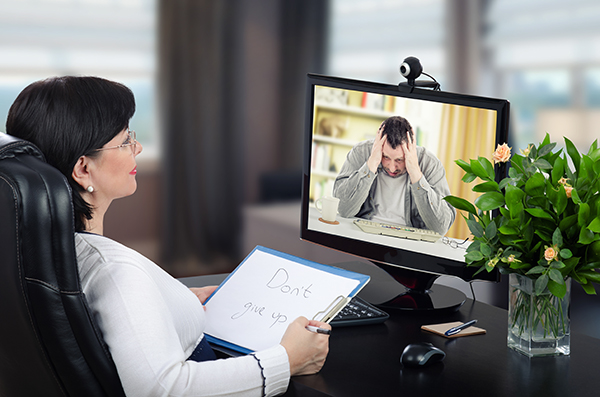From the Counselors Side of the Screen
Online counseling during the pandemic
Posted on August 15, 2020
 Right before the pandemic hit and hit hard closing down businesses and causing families to quarantine with the Governor’s Stay-at-Home orders, I sat with a client I’ll call Jake in my Bainbridge Island office. Jake, sixteen–years old was more fidgety than usual and his anxiety symptoms were running high. We had been working together for about a year on Jake’s Generalized Anxiety Disorder and he had made great strides in reducing his stress and anxiety, but here he was on my couch wringing his hands and talking about COVID-19 and the fact that his high school would be going to online learning. “Does this mean I won’t be able to see you?” Jake asked. I scrambled for an answer to his question as my mind raced with thoughts of doing Telehealth and not having a clue what was involved. Even though I was an “essential business,” I had to minimize my own risk and stay healthy and safe by closing my face-to-face practice temporarily. I took a breath and said, “Yes, of course I will continue to see you, but it will be online.” Jake look relieved and asked me how that worked. I told him I’d figure it out and be in touch and assured him that we’d meet the following week on screen.
Right before the pandemic hit and hit hard closing down businesses and causing families to quarantine with the Governor’s Stay-at-Home orders, I sat with a client I’ll call Jake in my Bainbridge Island office. Jake, sixteen–years old was more fidgety than usual and his anxiety symptoms were running high. We had been working together for about a year on Jake’s Generalized Anxiety Disorder and he had made great strides in reducing his stress and anxiety, but here he was on my couch wringing his hands and talking about COVID-19 and the fact that his high school would be going to online learning. “Does this mean I won’t be able to see you?” Jake asked. I scrambled for an answer to his question as my mind raced with thoughts of doing Telehealth and not having a clue what was involved. Even though I was an “essential business,” I had to minimize my own risk and stay healthy and safe by closing my face-to-face practice temporarily. I took a breath and said, “Yes, of course I will continue to see you, but it will be online.” Jake look relieved and asked me how that worked. I told him I’d figure it out and be in touch and assured him that we’d meet the following week on screen.
The pressure was on! I had a computer and a phone, but what about a secure Telehealth platform, consent forms, and record keeping? Would I need any other equipment and if so, how much would it cost? What would I miss in non-verbal cues that could be lost on camera (i.e. Jack’s foot tapping when he got anxious)? I drove home with these thoughts on my mind and then set to work spearheading what it was going to take to do successful Telehealth.
 I first looked into Zoom, but found it was not a secure platform unless I wanted to pay $200 a month for this feature. I didn’t. I wasn’t sure if my in-person clients would stick with me during this digital transition (I did lose a few, but gained so many more). I was talking to a colleague one day on the phone and they mentioned Doxy.me. I checked it out online and although it’s a free and secure healthcare platform, I decided to pay the professional upgrade rate of $35.00 per month to ensure better connectivity and a few other perks. Doxy.me has been wonderful. The hardest part in using this Telehealth platform was getting used to seeing myself mirrored in the screen doing therapy! I was not going to get away with unbrushed hair and no make-up when my clients would be getting an up close and personal view of me on camera.
I first looked into Zoom, but found it was not a secure platform unless I wanted to pay $200 a month for this feature. I didn’t. I wasn’t sure if my in-person clients would stick with me during this digital transition (I did lose a few, but gained so many more). I was talking to a colleague one day on the phone and they mentioned Doxy.me. I checked it out online and although it’s a free and secure healthcare platform, I decided to pay the professional upgrade rate of $35.00 per month to ensure better connectivity and a few other perks. Doxy.me has been wonderful. The hardest part in using this Telehealth platform was getting used to seeing myself mirrored in the screen doing therapy! I was not going to get away with unbrushed hair and no make-up when my clients would be getting an up close and personal view of me on camera.
The second order of business was creating a safe, confidential space in my home from which to conduct the video sessions. I moved boxes of books and put them neatly on the shelves. I made sure the background that clients could see was void of clutter and that it was quiet and serene in my home office as much for me as it was for the client. I knew that this would be new for both of us and that making a safe emotional container was essential – just as it was in person. My standards were the same, but the playing field was a little different, to say the least.
Once I had readied my home office and hung an “in-session” sign on my door, I called all of my clients and let them know that I’d be transitioning to Telehealth and did they want to continue in therapy. All but three clients out of my caseload of twenty-five gave me a resounding yes. Once I explained how Telehealth would work they were on board to give it a try. Overtime I got many more referrals from EAP’s, Children’s Hospital in Seattle, and from attorneys all over Western Washington. One of the great things about doing Telehealth is that clients that might not normally be able to access services due to travel distance and even social phobia can meet me in the comfort of their homes – sometimes even in their pajamas. One of my Doxy clients likes to take a walk in the woods while having her session. Others are proud to show off their homes and give me an inside peek into their lives.
My first Telehealth session was with Jake and I was a bit apprehensive about how it would go as this was all new to me. Doxy.me is incredible user-friendly though and after I sent Jake a link he was in my virtual waiting room in minutes.
At first both Jake appeared to be a bit self-conscious – he kept adjusting the camera on his end while I made sure to stay steady and focused as always. Jake avoided eye-contact as if this were the first time he had seen me. I was careful to keep eye-contact, but not stare and most of all not to keep checking my own image on the upper right hand side of the screen that was admittedly hard at first.
Jake began to relax as he heard the sound of my voice, but at times said, “this is different.” I self-disclosed that this was different for me too, and a learning curve for both of us. In some ways the screen is a barrier and in some ways it pulls me in closer to my client as many have felt more open to disclose intimacies and secrets that might have been difficult to talk about in-person.
Initially doing Telehealth seemed to take more effort than seeing my clients in-person. I puzzled as to why that was and came up with this: I had to be more vigilant for the non-verbals, I was learning a new technology and a new way of counseling. Newness can make me tired! I worried that my clients would not take to this way of counseling, but as my practice has increased two-fold with Telehealth that has not been a problem.
Periodically I ask my clients if they miss meeting in-office and the vast majority answer “no” – they have gotten used to this way of meeting and find it almost as good as meeting in-person and sometimes better when there have been travel constraints or a client is particularly shy and introverted.
I am sold on Telehealth and believe that it is the wave of the future. Premera, one of the major Northwest insurance companies promises to cover Telehealth at the same rate as face-to-face therapy through December 2020. I am confident that insurance companies will continue to pay for this service long after the pandemic is under control. Clients use it. Therapists that I’ve talked to for the most part, like it.
I’ve found that counseling from the other side of the screen works optimally for me. I don’t have the stress of a long commute and I can make myself a cup of tea between clients. Evidently I’m a Telehealth convert, although I do miss the routine of going into the office from time to time but have opted out of doing that for the time being. Now my biggest question is should I give up my physical office space? I'm getting a rent reduction of 25% after asking my landlord and since I have secure Wifi I will most likely keep the office in hopes that the pandemic will abate at some point!
Martha Wakenshaw is licensed Mental Health Counselor who specializes child, adolescent and adult therapy operating in Bainbridge, Washington.
See: Washington State Telehealth Implementation Guidebook
SEE ALSO:
More Mental Health Articles
Sexual Bias Articles
Race Relations Articles
How Drugs and Alcohol Affect the Brain and Body
WA. Counselor Directory: find a therapist near you
How helpful is this web page to you?
(and how can we can improve this page for you?)
not helpful
very helpful
Other Articles
Therapy During a Pandemic
Webmaster comment: A few weeks ago, I had trouble sleeping. With the stay-at-home orders from governors and the president, and the social-distancing movement saying to stay 6 feet apart, to... read more
Telemedicine is here to stay
It’s hard to imagine that the devastating pandemic we’re living through could possibly have a silver lining, but I think I’ve found one: telemedicine. Traditionally, health care has bee... read more
Telehealth advice for Counselors.
Special Notice: Beginning January 1, 2021, health care professionals (excluding physicians) who are offering telemedicine services to patients, are required to complete telemedicine training. S... read more



